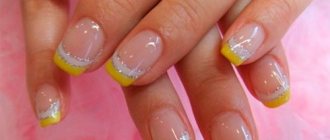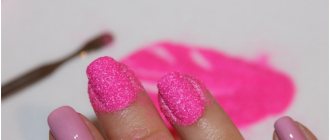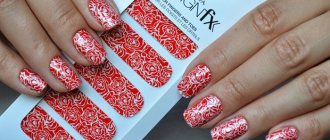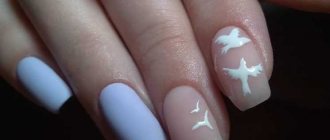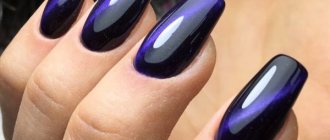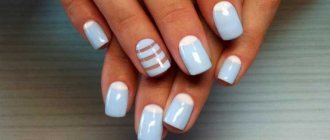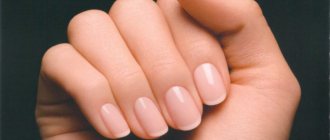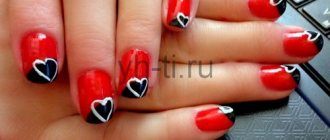What kind of manicure is there?
For most men, the presence of any color coating on a woman’s nails is already a manicure. They rarely understand extensions, shellac, French and other options, and the absence of color is equivalent to the absence of a manicure. Women are able to tell much more about the types of coating - give arguments for and against gel with acrylic, talk about the latest trends in nail art, even describe the most current nail shapes for the current season.
However, types of manicure are primarily divided according to the purpose pursued by this procedure, and after only 1 category will continue to branch according to:
- technicians;
- types of coverage;
- design decision.
Medical
This type of manicure is little known because, firstly, it is performed only in medical institutions and by a specialist with appropriate education. A simple master in a beauty salon will not give you a medical manicure, because... does not have:
- proper conditions (especially sterility of the office);
- tools;
- drugs;
- skills.
The purpose of this procedure is not the beauty of nails and well-groomed hands, but their health. The indication for a medical manicure is any fungal disease that affects the specified area, so the client’s gender does not play a role. Some girls do this manicure at home, but according to doctors, it is undesirable to do this, because... Without medical education, you cannot guarantee the complete safety and correctness of your actions.
Cosmetic
The main type of manicure, which is already performed at almost every step, since the number of masters in this field has increased significantly. It can be done at home, in a studio, or in a beauty salon. Depending on the degree of complexity, the duration of the procedure, the required conditions, instruments, and medications vary. The purpose of a cosmetic manicure is to create and maintain the beauty of the skin of the hands (!) and the nail plate. If the master does not apply a color coating, the procedure loses its gender identity and it is possible that it can be performed on a man.
How to perform a coated manicure
The whole process fits into several stages:
- Before applying the base coat, the nail plate is degreased and sometimes even sanded. And the cuticle is removed.
- Then apply the base coat in a thin layer, carefully painting all areas of the nail. Once the coating is applied, it is dried.
- Next, the nail is covered with the desired color, which is applied in several layers. In this case, each layer dries, as a rule, for 3-5 minutes - this depends on the characteristics of the product itself.
- After the color coating is formed, it is additionally coated with a fixing composition. And they let this whole mass dry.
Manicure technique
Before a colored coating appears on your nails, the master must prepare them: evaluate and improve the condition of the cuticle, equalize the length, and, if necessary, change the surface relief of the plate. This type of manicure takes relatively little time to complete, because... What matters here is mainly the aesthetic side of the issue. If you decide to refuse coating and are pursuing a purely hygienic or therapeutic goal, the technician will work longer and his key task will be to provide your hands and nails with an ideal look without varnish.
A few basic rules:
- all types of manicure require clean hands, which need to be treated with a disinfectant, especially if you use nippers;
- never try to file a softened wet nail or cut a dry one;
- polishing nails is allowed no more than once a week.
Edged
Even today, this procedure has the same look that was familiar to women of Soviet times: it is a classic manicure using nippers to help get rid of hangnails and cuticles. There are many opponents and defenders of this type of hand care: even professionals have not formed a unified attitude towards trimmed manicure. However, if you suffer from very dry, dense and actively growing cuticles, you cannot cope with it without trimming. In other cases, it is advisable to get by with an unedged manicure, because:
- the skin is severely injured;
- high risk of infection;
- scissors and wire cutters can create deep depressions near the hole;
- You need to do a trim manicure every week.
Hot
This type is characterized by the use of baths with salt, oils, herbal decoctions, etc., which have a positive effect on the condition of the skin of the hands and the nail plate, but are primarily performed for the subsequent removal of the cuticle and pterygium. During the hot manicure procedure, the skin is steamed and softened, dead cells are easily removed with a pusher - a metal tool that looks like a spatula. Children's manicures are performed primarily using this technology.
If you do this procedure at home, remember that:
- You need to remove the length before the bath, if you cut it, and after, if you cut it;
- The coating can be applied only after the water has completely evaporated from the nail plate.
Hardware
Based on the principle of working with the cuticle, this manicure technique is similar to trimming, because a mechanical effect is exerted on the skin. However, the master does not use piercing and cutting tools, but works with special attachments called cutters. They act in the same way as a nail file, but due to their shape and high rotation speed, they get rid of pterygium, cuticle, side ridges and dry areas, even in hard-to-reach areas and without injury. If we talk about safe and popular types of manicure that give excellent results, then hardware has a leading position.
European unedged
Professionals call European manicure the safest type of manicure. The key point of this technique is the use of special preparations, keratolics, which, due to their aggressive chemical composition, promote the dissolution of the cuticle and pterygium. Afterwards, the remnants of the softened skin are cleaned off with an orange stick or a pusher. The only problem with European manicure is that the thick cuticle under such products will not even soften, and there is no talk of dissolving. Switching to it from an edged one is also difficult - the process can take up to six months.
Japanese
If other types of manicure primarily prepared the nails for further manipulation, the Japanese one, which became popular only a couple of seasons ago, called “glossy,” does not imply any decorative coating. This is a therapeutic type procedure that is recommended for girls:
- with thin, brittle nails;
- suffering from plate delamination;
- after extension;
- after wearing gel polish for a long time.
If desired, Japanese manicure can be made part of a regular hand care system. It consists of several stages: it begins with diagnosing the condition of the areas adjacent to the nail, after which the nail plate is sealed with a special compound and polished. The final stage is massage. The products used for Japanese manicure have several types, since they are selected individually.
Spa
A popular type of hand care procedure is a spa manicure, the task of which is the same as that of the Japanese one: to achieve not only a cosmetic effect, but also a therapeutic one. Through the use of special products and a whole range of procedures, the skin is given well-groomed, and the nails are given strength and a healthy shine. Spa manicure is distinguished from other types by its multi-stage nature, because... includes:
- peeling;
- nourishing mask;
- wrap (paraffin therapy);
- length correction;
- removal of the cuticle using substances that dissolve it (i.e., the method of the European procedure);
- plate polishing;
- hand massage.
Benefits of the procedure
Manicure with gel coating is recognized as the most gentle option for nail design, since the nail plate is not filed down during the process. On the contrary, this procedure leads to the strengthening of the natural nail and the elimination of many problems with it: delamination, cracking, and the like.
The manicure lasts for a long time, since the gel coating in several layers creates a durable shell. At the same time, the shell itself thickens slightly, preserving the nail its natural size and at the same time giving it a correct and beautiful shape.
When it comes to design, there are no restrictions! But most often they choose a classic coated or French , since it suits any wardrobe and event. Its versatility is its advantage. In addition, it is the French manicure that creates the full illusion of natural nails, and its price corresponds to any financial capabilities.
Types of nail coating
If in the last century a manicure could only be done with varnish, and even the number of colors significantly limited one’s imagination, the modern market of products for nail artists offers a lot of new products. Long-term coatings have become available to women, the only drawback of which is the need to purchase professional devices and products, know the features of each application, and study the technology of working with different types of compositions. Keep in mind that you cannot polish your nails before applying any coating - there will be nothing for the product to cling to.
Regular varnish
The most unstable, but affordable type of coating that a woman can handle herself is colored varnish. The assortment presented in stores even eliminates the need to come up with a design: the consumer is offered not only a variety of shades, but also textures and effects. Magnetic, sand, changing tone under the influence of temperature - you don’t have to visit the salon, and almost all types of manicure designs are also easy to master on your own. However, varnish has disadvantages:
- lasts only a couple of days;
- for a beautiful result you will have to work hard on careful application;
- the thickness of the layer must be carefully adjusted;
- long drying.
- Zinc acne ointment
- How to spy on a person via phone and computer. Subscriber tracking programs
- Use of valerian
Gel polish coating
If a woman prefers long-term coverage and manicure visits no more than 2 times a month, the master can suggest she use gel polish. This decorative coating option became a compromise between extensions and standard varnish application. The main product is based on acrylate, which hardens under UV or LED rays, so a lamp is needed to work with gel polish. Among the advantages of this coating:
- it will visually strengthen the nails, so the free edge underneath can grow without breaking;
- gloss, density inherent in gels;
- self-leveling during execution;
- no chips or end wear;
- minimum harm, because The master does not file the surface.
Shellac
It is illogical to divide gel polish and shellac into different types of manicure, since gel polish is the general name of a product based on acrylate that hardens under radiation. Shellac is the name of the “brainchild” of the CND company, the first gel polish that brought the salon manicure service to a new level. Other brands do not have the right to use this word in describing their products. Its properties are the same as all gel polishes. He:
- persistent;
- not afraid of water;
- lasts up to 2 weeks (the period is determined by the characteristics of the nail plate - the coating lasts longer on a dry surface);
- does not lose color and gloss;
- cannot be performed without a lamp.
Acrylic coating
The types of manicure listed above only implied the creation of a decorative coating, i.e. colors, but the use of acrylates (acrylic and gel) is always modeling. Experts do not recommend resorting to them just to seal the nail: the reason for working with such materials must be more serious. The use of acrylates helps:
- adjust the shape;
- add the missing sections of the free edge (you can restore 1 broken nail, etc.);
- make your nails narrower.
Modeling with acrylic/gel under varnish involves performing a standard manicure procedure (mainly an unedged look) and the subsequent use of camouflage - a high-density flesh-colored composition. The result is an even plate on which any coating will last longer, and the growing edge will not break suddenly.
Types of nail designs
When a monochromatic coating gets boring and a woman wants something new, she begins to study manicure styles in photo galleries. Among modern trends, experts identify several types of design that a master can offer to a client:
- airbrush;
- French;
- lunar design;
- stamping;
- drawing;
- use of stickers;
- design with fabric, foil, mica;
- crystal pixie and other rhinestones.
French
A classic, akin to the little black dress, was and will remain the French manicure. In its traditional form, it represents the natural tone of the nail plate and a white tip - something that can be done even without the help of a master, if you practice a little. Later, different types of manicure of this type appeared: white color was replaced by brighter ones - red, yellow, green, etc. According to the French pattern, they even make a design without a natural tone: as an example, a white nail plate and a purple edge.
Lunar
Some craftsmen call this type of design reverse French, because... the idea is to highlight not the free edge, but the hole adjacent to the base, but maintaining the same semicircular shape. In some cases, it is not filled with color, but remains blank. Carrying out a lunar design yourself is more difficult than a French design, because... there is a high probability of staining the cuticle, and choosing an individual stencil is difficult.
Gradient
This type of design can be performed with a special device - an airbrush: this is how beauty salon masters work. At home, the gradient is made with a sponge, onto which the desired number of shades of varnish is applied and mixed. The result is a soft transition as the colors flow into each other. This design method is less labor-intensive than creating a drawing and allows for some negligence. The gradient on short nails is not placed horizontally - it is better to make the lines diagonal so that they visually lengthen the plate.
Lace
Masters often offer this option to brides, since the nails take on a neat appearance that is ideal for a wedding dress, no matter what style it is. For the design, pieces of thin lace purchased at a nail art store are used - simple fabric will not work due to its density and the pattern is too large (compare with the surface area of the nail). The lace is applied to the free edge or to the entire nail plate, sitting on glue or a special product. Be sure to cover it with a top coat to remove excess relief.
Using stamping
A young trend in design called “stamping” can also give your nails an interesting look. It uses a special disk with patterns cut into it, which are filled with paint and carefully transferred with a stamp to the prepared nail. An important nuance is the consistency of the varnish: it cannot be too liquid, otherwise the design will float. If you practice, a manicure with stamping can take you only 10 minutes.

